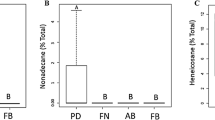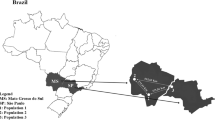Abstract
The dominance hierarchy in primitively eusocial insect societies has been shown to be mainly regulated through aggressive interactions. Females that are generally more dominant stand out and occupy the queen position, meaning that they monopolize reproduction while others perform other tasks. Chemical communication is important for maintaining social cohesion. Cuticular hydrocarbons are recognized as the main molecules responsible for mediating social interactions, especially nestmate recognition and queen signalling. Many highly eusocial groups have been studied in recent years, but primitively eusocial groups, which are key to understanding the evolution of social behavior, remain unexplored. In this study, we investigated the connection between cuticular hydrocarbons in females expressed in different social contexts in the primitively eusocial wasp Mischocyttarus cerberus. Colonies in two different ontogenetic phases, pre- and post-worker emergence, were used. We observed and categorized behavioral interactions between individual females and collected all individuals in a nest to obtain information on size, ovary activation and chemical composition. Furthermore, we conducted experiments in which the alpha (dominant) females were removed from nests to produce a new dominance hierarchy. We found that females in different hierarchical positions had small chemical difference corresponding with ovary activity. Our results support the hypothesis that cuticular hydrocarbons are associated with social context in this primitively eusocial species, with some compounds being associated with hierarchical position and ovarian activity.



Similar content being viewed by others
References
Altmann J (1974) Observational study of behavior: sampling methods. Behaviour 49:227–266
Andrade AC, Miranda EA, Del Lama MA, Nascimento FS (2016) Reproductive concessions between related and unrelated members promote eusociality in bees. Sci Rep 6:26635. https://doi.org/10.1038/srep26635
Andrade-Silva ACR, Nascimento FS (2015) Reproductive regulation in an orchid bee: social context, fertility and chemical signalling. Anim Behav 106:43–49. https://doi.org/10.1016/j.anbehav.2015.05.004
Blomquist GJ, Bagnères AG (2010) Insect hydrocarbons: biology, biochemistry, and chemical ecology. Cambridge University Press
Breed MD, Gamboa GJ (1977) Behavioral control of workers by queens in primitively eusocial bees. Science 195:694–696
Cappa F, Beani L, Cervo R (2016) The importance of being yellow: visual over chemical cues in gender recognition in a social wasp. Behav Ecol 27:1182–1189. https://doi.org/10.1093/beheco/arw025
da Silva RC, da Silva AP, Assis DS, Nascimento FS (2019) Occurrence and nesting behavior of social wasps in an anthropized environment. Sociobiology 66:381–388. https://doi.org/10.13102/sociobiology.v66i2.4303
De Souza AR, Figueiredo BBM, Ribeiro B, Pinheiro R, Justino L, De Castro MM, Prezoto F (2011) The performance of dominance indices for constructing dominance hierarchies in Mischocyttarus and Polistes wasps (Hymenoptera, Vespidae). Fla Entomol 94:869–873. https://doi.org/10.1653/024.094.0422
De Souza A, Mourão CA, Do Nascimento FS, Lino-Neto J (2014) Sexy faces in a male paper wasp. PLoS One 9:1–6. https://doi.org/10.1371/journal.pone.0098172
Deshpande SA, Sumana A, Surbeck M, Gadagkar R (2006) Wasp who would be queen: a comparative study of two primitively eusocial species. Curr Sci 91:332–336
Endler A, Liebig J, Hölldobler B (2006) Queen fertility, egg marking and colony size in the ant Camponotus floridanus. Behav Ecol Sociobiol 59:490–499. https://doi.org/10.1007/s00265-005-0073-0
Ferreira AC, Neves EF, dos Santos MT, Mendonça A, Cardoso CAL, Junior WFA (2017) Intraspecific variation of the composition of linear alkanes in social wasp Mischocyttarus consimilis. Sociobiology 64:466–476. https://doi.org/10.13102/sociobiology.v64i4.1857
Giannotti E (1999) Social organization of the eusocial wasp Mischocyttarus cerberus styx (Hymenoptera: Vespidae). Sociobiology 33:325–338
Izzo A, Wells M, Huang Z, Tibbetts E (2010) Cuticular hydrocarbons correlate with fertility, not dominance, in a paper wasp, Polistes dominulus. Behav Ecol Sociobiol 64:857–864. https://doi.org/10.1007/s00265-010-0902-7
Keller L, Nonacs P (1993) The role of queen pheromones in social insects: queen control or queen signal? Anim Behav 45(4):787–794
Lenth, R. V. (2017). Using lsmeans. J Stat Softw 69:1–33
Liebig J, Peeters C, Oldham NJ, Markstädter C, Hölldobler B (2000) Are variations in cuticular hydrocarbons of queens and workers a reliable signal of fertility in the ant Harpegnathos saltator? Proc Natl Acad Sci USA 97:4124–4131. https://doi.org/10.1073/pnas.97.8.4124
Litte M (1977) Behavioral ecology of the social wasp, Mischocyttarus mexicanus. Behav Ecol Sociobiol 2:229–246
Miller SE, Bluher SE, Bell E, Cini A, da Silva RC, de Souza AR, Gandia KM, Jandt J, Loope K, Prato A, Pruitt JN, Rankin D, Rankin E, Southon RJ, Uy FMK, Weiner S, Wright CM, Downing H, Gadagkar R, Cristina Lorenzi M, Rusina L, Sumner S, Tibbetts EA, Toth A, Sheehan MJ (2018) WASPnest: a worldwide assessment of social Polistine nesting behavior. Ecology 99:2405
Monnin T, Malosse C, Peeters C (1998) Solid-phase microextraction and cuticular hydrocarbon differences related to reproductive activity in queenless ant Dinoponera quadriceps. J Chem Ecol 24:473–490
Monnin T, Peeters C (1999) Dominance hierarchy and reproductive conflicts among subordinates in a monogynous queenless ant. Behavioral Ecology 10(3):323–332
Monnin T, Ratnieks FL, Jones GR, Beard R (2002) Pretender punishment induced by chemical signalling in a queenless ant. Nature 419:61–65
Mora-Kepfer (2014) Context-dependent acceptance of non-nestmates in a primitively eusocial insect. Behav Ecol Sociobiol 68:363–371. https://doi.org/10.1007/s00265-013-1650-2
Murakami AS, Shima SN, Desuó IC (2009) More than one inseminated female in colonies of the independent-founding wasp Mischocyttarus cassununga von Ihering (Hymenoptera, Vespidae). Rev. Bras Entomol 53:653–662. https://doi.org/10.1590/S0085-56262009000400017
Noda SCM, Silva ERD, Giannotti E (2001) Dominance hierarchy in different stages of development in colonies of the primitively eusocial wasp Mischocyttarus cerberus styx (Hymenoptera, Vespidae). Sociobiology 38:603–614
Oi CA, van Zweden JS, Oliveira RC, Van Oystaeyen A, Nascimento FS, Wenseleers T (2015) The origin and evolution of social insect queen pheromones: novel hypotheses and outstanding problems. BioEssays 37:808–821. https://doi.org/10.1002/bies.201400180
Oi CA, Millar JG, van Zweden JS, Wenseleers T (2016) Conservation of queen pheromones across two species of vespine wasps. J Chem Ecol 42:1175–1180. https://doi.org/10.1007/s10886-016-0777-9
Oi CA, Oliveira RC, van Zweden JS, Mateus S, Millar JG, Nascimento FS, Wenseleers T (2019) Do primitively eusocial wasps use queen pheromones to regulate reproduction? A case study of the paper wasp Polistes satan. Front Ecol Evol 7:199. https://doi.org/10.3389/fevo.2019.00199
Pardi L (1948) Dominance order in Polistes wasps. Physiol Zool 21:1–13
Peeters C, Monnin T, Malosse C (1999) Cuticular hydrocarbons correlated with reproductive status in a queenless ant. Proc R Soc Lond B Bio 266:1323–1327. https://doi.org/10.1098/rspb.1999.0782
R Core Team (2019) R: A language and environment for statistical computing. R Foundation for Statistical Computing, Vienna. URL https://www.R-project.org/
Reeve HK (1991) Polistes. In: Ross KG, Matthews RW (eds) Thesocial biology of wasps. Cornell University Press, Ithaca, pp 99–148
Rouault JD, Marican C, Wicker-Thomas C, Jallon JM (2004) Relations between cuticular hydrocarbon (HC) polymorphism, resistance against desiccation and breeding temperature; a model for HC evolution in D. melanogaster and D. simulans. In Drosophila melanogaster, Drosophila simulans: so similar, so different. Springer, Dordrecht, pp 195-212
Singmann H; Kellen D (2017) An introduction to mixed models for experimental psychology. New Methods in Neuroscience and Cognitive Psychology
Sledge MF, Boscaro F, Turillazzi S (2001) Cuticular hydrocarbons and reproductive status in the social wasp Polistes dominulus. Behav Ecol Sociobiol 49:401–409. https://doi.org/10.1007/s002650000311
Slessor KN, Wiston ML, Le Conte Y (2005) Pheromone communication in the honeybee (Apis mellifera L.). J Chem Ecol 31:2731–2745. https://doi.org/10.1007/s10886-005-7623-9
Smith AA, Hölldober B, Liebig J (2009) Cuticular hydrocarbons reliably identify cheaters and allow enforcement of altruism in a social insect. Curr Biol 19:78–81. https://doi.org/10.1016/j.cub.2008.11.059
Strassmann JE, Meyer DC (1983) Gerontocracy in the social wasp, Polistes exclamans. Anim Behav 31:431–438
Tannure-Nascimento IC, Nascimento FS, Zucchi R (2008) The look of royalty: visual and odour signals of reproductive status in a paper wasp. Proc R Soc Lond B Bio 275:2555–2561. https://doi.org/10.1098/rspb.2008.0589
Tibbetts EA (2002) Visual signals of individual identity in the wasp Polistes fuscatus. Proc R Soc B Biol Sci 269:1423–1428. https://doi.org/10.1098/rspb.2002.2031
Tibbetts EA (2006) Badges of status in worker and gyne Polistes dominulus wasps. Ann Zool Fennici 43:575–582
Van Oystaeyen A, Oliveira RC, Holman L, van Zweden JS, Romero C, Oi CA, d’Ettorre P, Khalesi M, Billen J, Wäckers F, Millar JG, Wenseleers T (2014) Conserved class of queen pheromones stops social insect workers from reproducing. Science 343:287–290. https://doi.org/10.1126/science.1244899
van Zweden JS, Bonckaert W, Wenseleers T, d'Ettorre P (2014) Queen signaling in social wasps. Evolution 68:976–986. https://doi.org/10.1111/evo.12314
Vickruck JL, Richards MH (2018) Linear dominance hierarchies and conditional reproductive strategies in a facultatively social carpenter bee. Insect Soc 65:619–629. https://doi.org/10.1007/s00040-018-0653-4
West-Eberhard MJ (1977) The establishment of reproductive dominance in social wasp colonies. Proc 8th Intl Congr IUSSI, Wageningen, the Netherlands, pp 223–227
Wilson EO (1971) The insect societies. Harvard University Press, Cambridge
Acknowledgments
We would like to thank the two anonymous reviewers for their comments and suggestions on earlier versions of this manuscript. This study was financed by Coordenação de Aperfeiçoamento de Pessoal de Nível Superior, Brasil (CAPES) Finance Code 001 and grant to RCS 2018/22461-3 and APS proc. n° 2016/11887-4 São Paulo Research Foundation (FAPESP). Additional funding was provided from a bilateral grant FWO-FAPESP to CAO and FSN (process: 2018/10996-0 FAPESP and FWO: GOF8319N), Research Foundation Flanders to CAO (postdoctoral fellowship FWO-12V6318N and international mobility grant FWO V449117N), and Conselho Nacional de Desenvolvimento Científico e Tecnológico to APS under grant 142285/2018-8.
Author information
Authors and Affiliations
Corresponding author
Ethics declarations
Conflict of Interest
The authors declare that they have no conflicts of interest.
Rights and permissions
About this article
Cite this article
da Silva, R.C., Prato, A., Oi, C.A. et al. Dominance Hierarchy, Ovarian Activity and Cuticular Hydrocarbons in the Primitively Eusocial Wasp Mischocyttarus cerberus (Vespidae, Polistinae, Mischocyttarini). J Chem Ecol 46, 835–844 (2020). https://doi.org/10.1007/s10886-020-01206-1
Received:
Revised:
Accepted:
Published:
Issue Date:
DOI: https://doi.org/10.1007/s10886-020-01206-1




